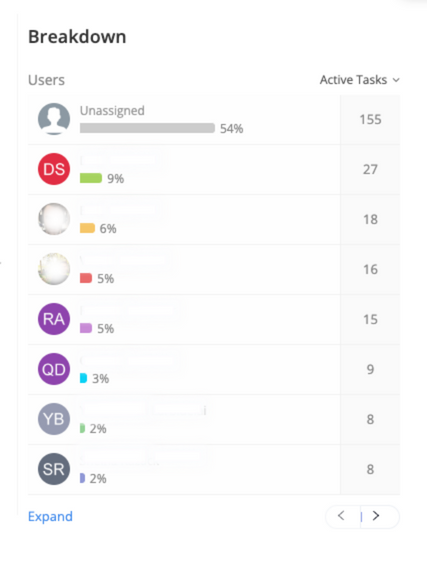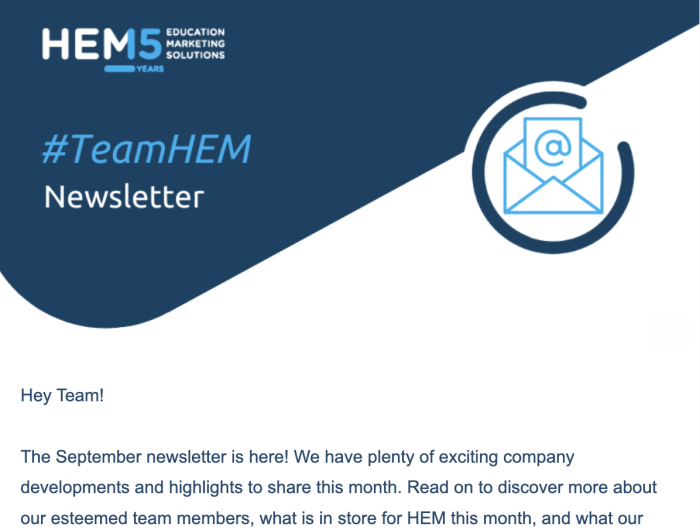In today’s evolving work environment, team productivity is a concern in many organizations. Since hybrid and remote work formats have gained popularity, many marketing managers wonder how to balance their team’s productivity and well-being. In the education industry, many schools are increasingly investing in strategies and resources to address these concerns and foster a productive team culture amid these changing work dynamics.
At HEM, we often ask each other, “What makes a team productive?” While there’s no right answer to this question, team productivity can be nurtured and enhanced by fostering a work environment where clear communication and the team’s well-being are at the forefront. Over the years, we’ve implemented different strategies to optimize our team’s performance while providing everyone with a friendly work environment. Keep reading to discover some tips that have helped us, and that can help you keep your marketing team productive.
1. Make Sure Everyone Knows Their Role and Responsibilities
The first thing you pay attention to if you are trying to keep your marketing team productive is roles and responsibilities. Without these two elements, it is improbable that your team will be successful, as clarity in roles and responsibilities is the cornerstone of effective teamwork. Suppose your team members don’t have a clear understanding of their responsibilities. In that case, there’s a heightened risk that tasks may be duplicated, essential duties might be overlooked, and overall productivity could suffer. If you’re struggling with team productivity challenges, one or more team members are likely uncertain about their tasks, eventually hindering your team’s overall performance.
So, How do you build a strong marketing team? To build a strong team, you should get to know the strengths and weaknesses of your team members and align their roles accordingly. Though it might seem rather easy to have clearly defined roles, those who manage marketing teams know how difficult this can get. Teams are rarely fixed, so each time a person enters or leaves your team, responsibilities need to be reassessed. To keep track of this, you can begin by listing all the tasks your team is responsible for. Once you have this list, you can identify which team members are best suited for each task, considering their skills, expertise, and preferences. This allocation of responsibilities ensures that tasks are assigned to the most qualified individuals and fosters a sense of ownership and accountability within the team.
While establishing fixed roles is essential, one must be open to adjustments. To ensure a fair workload distribution, you should keep doing these reassessment tasks as your projects change and progress. Consider implementing a shared calendar or a project management timeline to streamline this process. For example, you can create a content calendar for your school’s content team in which you keep track of your content development while at the same time letting other team members know who is in charge of what. If you use project management tools, you can also monitor how much your team members contribute to your projects to ensure you are not relying too much on just one person.
Example: You can create production and publication calendars to keep track of your team’s progress.

Did you know that a digital marketing audit can uncover gaps and opportunities for growth for your school? Discover our digital marketing services for schools!
2. Use These Project Management Tools to Keep Your Marketing Team Productive
As mentioned, project management tools can be handy for boosting your team’s productivity. In addition to keeping your team members on track with their tasks, project management tools can also help you automate processes and centralize information, allowing you to reduce the time and effort required for various team activities.
Since high-performing marketing teams often juggle multiple projects simultaneously, project management tools can be the ideal solution to maintain efficiency and organization. These tools offer features such as task assignment, progress tracking, and collaboration spaces that allow team members to work seamlessly across various projects. You can also use these tools to keep documents organized, making it easier for team members to find what they need and stay on top of their responsibilities.
If your school is not using these tools yet, here are some that you might want to try:
- Trello: Trello is a project management and collaboration tool that uses a visual, card-based system to help teams and individuals organize tasks and projects.
- Teamwork: Teamwork is a project management software developed for team collaboration and client work. This software can provide you with a breakdown of tasks, responsibilities, and timelines, among other things.

- Monday: Monday is a portfolio project management tool for collaboration and tracking.
- HEM’s Student Portal: Our student portal is an all-in-one admissions management and student information system for educational institutions. It centralizes operations for admissions teams, academic faculty, and support staff.
- Hootsuite: Hootsuite is a platform for managing social media. It allows teams to collaborate on social media content creation, approval, and scheduling.
- HubSpot: HubSpot is primarily known for its Customer Relationship Management (CRM) system. It helps teams manage customer interactions, track leads, and monitor sales pipelines. In addition, it offers tools for email marketing, social media marketing, SEO, and content management, among others.
- Mautic by HEM: Mautic by HEM is a CRM and marketing automation solution designed specifically for the education sector. Though this is not a project management tool, your team can supercharge its productivity with its CRM automation tools.

3. Let Your Decisions Be Data-Driven
Data-driven insights are crucial for building a productive team. They provide an evidence-based approach to decision-making, performance evaluation, and continuous improvement, enabling your team to work smarter and achieve your school’s goals more efficiently. Data can also reveal trends and patterns in your marketing team’s performance. This information can be used to optimize goals, work schedules and processes. You can use your project management and CRM tools to generate reports, which can help you assess not only the performance of your team but also the effectiveness of your campaigns.
4. Clear Communication is Key
Effective communication in the workplace is key to keeping your marketing team productive. To begin with, clear communication ensures that information is conveyed accurately and understood by all team members. In addition, clear communication can help you prevent misunderstandings and keep everyone on the same page.
Open and honest communication is also essential for resolving conflicts and addressing issues promptly. If your school’s marketing team is not communicating, chances are your work quality will be adversely affected. If you’re wondering, “How can I make my marketing team better?” To build a high-performing team, establish clear communication channels–such as chats, emails, meetings, or catch-ups–and ensure everyone knows how to utilize them effectively.
Example: HEM’s internal monthly newsletter is a vital channel for sharing company updates, fostering community, and celebrating team achievements.

External communication with students, partners, and clients is also key, as clear and responsive communication builds trust and loyalty. CRM tools designed for the education industry can help you manage your contact list and communicate with prospective and current students, agencies, recruiters, alumni, and parents.
Finally, if you are collaborating with an education marketing agency, keep your point of contact updated with all the developments in your school. This will ensure that the content and material developed by the agency reflects your school’s values and current situation. This will help your school and the agency save time and deliver better results.
5. Prioritize Well-Being
There is no better way to improve team productivity than fostering a caring environment. Time and time again, we’ve witnessed how teams that don’t prioritize rest and mental clarity will likely encounter more problems and issues. While the way your school promotes well-being may vary and depend on your budget, you can begin by ensuring that everyone takes adequate breaks, has access to a calm environment, and that working hours are flexible enough to accommodate everyone’s schedules.
Well-being is also about fostering a human connection. Encouraging your marketing team members to get to know each other promotes a more pleasant and inclusive work environment and enhances team dynamics. For example, at HEM, all our teams have weekly virtual meetings to discuss company updates, project developments, and their daily lives. Managers meet in person every other month, and we organize events for special occasions.

6. Set Clear and Realistic Goals and Deadlines for Your Team
Like roles and responsibilities, goals and deadlines drive your team’s productivity and success. Goals provide a clear direction for individual teams and the entire company and can help ensure everyone is on track. In addition, when every team member is well-informed about the company’s overarching goals and understands the direct impact of their work on achieving these objectives, it fosters a strong sense of motivation. We have observed that when team members have a target to work towards, they often exhibit higher commitment and enthusiasm to achieve that goal. Thus, a good practice is aligning your team and company goals.
Goals also provide a clear basis for measuring progress and success. Additionally, they serve as a fundamental tool for resource allocation, enabling schools to make efficient use of time, personnel, and budgets. Organizations can channel their efforts strategically with well-defined goals, ensuring that every resource contributes to achieving these objectives.
Deadlines can create a sense of urgency, a powerful productivity driver. Knowing that a task must be completed by a certain date can encourage your marketing team members to manage their time effectively, prioritize tasks, and work more efficiently. If you are trying to keep your marketing team productive, you must ensure that everyone’s deadlines are realistic. This prevents burnout, allowing your team to meet their targets while maintaining a healthy work-life balance consistently.

7. Measure Your Team’s Performance
While measuring your team’s performance can be stressful, this should be done to understand your team’s limits and weaknesses. Instead of focusing on what your team should be doing, consider why your team cannot achieve your performance goals. Once you’ve identified your team’s obstacles, you can develop an action plan that can be implemented gradually. This will help you pave the way for a more effective, efficient, and successful team.
Performing audits and assessing your goals can also provide valuable insights into the time it takes each team member to accomplish tasks, enabling more equitable work distribution. For instance, conducting a digital marketing audit will not only help you identify the opportunities your school might be missing, but it can also help you discover ways your team can optimize its efforts.
8. Give Constructive Feedback
Finally, if your team members need to meet the anticipated results, ensure your feedback is constructive and supportive. Always frame feedback as solution-oriented, focusing on actions and outcomes rather than personal traits. While providing feedback to your team, you should encourage open dialogue by asking for their input while setting clear goals. For instance, if a content writer produces a piece that’s not up to your school’s standards, you can point out the gaps in the article and suggest actions to improve the piece they are working on and future pieces.
Furthermore, in addition to providing constructive feedback, it’s equally crucial to acknowledge and celebrate your team’s accomplishments. This can be done individually or as a team. Recognizing your team’s achievements will show appreciation for their work and help foster a positive work environment, enhance motivation, and contribute to the team’s continued success and productivity.







